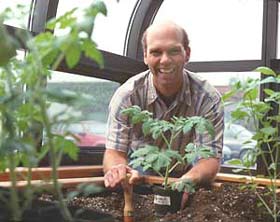
It's hard to imagine anything green in Vermont in winter. The dominant colors surrounding National Gardening's office building here in Burlington are blue sky, white snow, and black pavement. But creative thinking is exactly what greenhouse gardening takes, and one winter our collective imagination went wild when we attached a greenhouse onto the front of the building. Visions of ripe tomatoes, tropical fruit, and lush year round foliage danced in staffers' heads. Before I knew it, I was ordering plants, mixing soil, and planting seeds -- while the snow fell outside. As soon as the greenhouse was finished, I had seedlings ready to transplant.
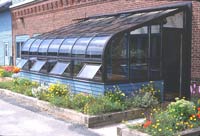
Blowing Hot and Cold
Our south-facing, 12- by 18-foot greenhouse, surrounded on three sides by a paved parking lot, doubles as the main entrance. The ceiling slopes from nine feet, at the end attached to the building, to six feet before dropping down to the three-foot kneewall. The back is open to the reception area and the entire building. It features two automatic ceiling vents, six windows, and double-pane, insulated (R 3.25), tinted glass. The glass tinting reflects heat producing, infrared rays away from the greenhouse, while allowing growth-inducing, ultraviolet rays to penetrate. The ceramic-tiled floor slopes to a corner dry well for water drainage.
One thing you can rely on in Vermont is the cold. To keep the greenhouse warm for human and plant life, we installed base-board heaters. With the help of soil mass, plant matter, and base-board heat, the soil temperature never drops below 60° F and the air temperature never drops below 56? F.
Keeping the greenhouse cool in summer is another matter. Even with all vents and windows open and portable floor fans blowing at high speed, temperatures inside the greenhouse still averaged 86? F during the first summer, and many days were uncomfortably well into the 90s. That's great for growing bananas, but quickly causes anyone working nearby to wilt. Sunshades and an exhaust fan installed prior to the following summer reduced the heat.
Room and Boards
We insist that our greenhouse balance aesthetics and practicality to keep plants and people happy. Hanging baskets of Carolina jasmine and scented geraniums, window sill pots of rosemary, chocolate pepperrmint, curry plant, and pineapple sage, planters of 'Dwarf Lady Finger' banana, 'Babaco' papaya, and 'Improved Meyer' lemon share the greenhouse with computers, desks, and people.
The main planting space in the greenhouse is a 12 1/2-foot-long by 32-inch-wide by 2 1/2-foot-tall raised bed that holds 62 cubic feet of soil, set in a waist-high cedar planter preserved with boiled linseed oil. The bed is raised 3 inches off the floor for better water drainage. The soil depth is 20 inches, and the inside walls of the bed are lined with black plastic. The bottom wooden slats are spaced 1/2 inch apart with 1-inch-diameter holes drilled every 6 inches to aid in water drainage. Wooden dividers separate the bed into three equal-sized compartments. If disease contaminates one compartment, the entire bed of soil doesn't have to be replaced.
Since the bed is located in the front of the greenhouse, where the sloping ceiling glass is 6 feet above the floor, we have only 50 inches of headspace to grow plants. For short plants, such as lettuce and greens, this is no problem; however, I learned quickly why commercial greenhouse growers start their tomatoes on the floor.
The soil mix is a compromise between pure organics and a standard greenhouse mix. My recipe is 18 cubic feet topsoil, 18 cubic feet peat moss, 12 cubic feet vermiculite, 12 cubic feet perlite, 240 pounds bagged, sterilized, composted cow manure, and 15 pounds of bonemeal.
With each new crop I add 40 pounds of composted cow manure. Transplants are fertilized with 2 tablespoons fish emulsion and 1 tablespoon seaweed mix per 1 gallon of water every 2 weeks. Each vegetable plant receives a handful of a complete organic fertilizer at planting time and is side-dressed with the same fertilizer monthly. The fruit planters, hanging flowers and potted herbs are fertilized with a controlled-release fertilizer every six months as well as other fertilizers, such as trace minerals for the lemon, to meet a specific plant's needs.
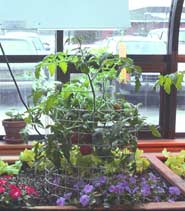
Trellised tomatoes
Every greenhouse grower has been lured by the idea of fresh tomatoes year round. I'm no exception. Tomatoes are my main crop. The first year I tried the following five greenhouse tomato varieties: 'Caruso', 'Vendor', 'Sierra', 'Danny', and 'Buffalo'. Tomatoes grow easily in the greenhouse. Although the blossoms are self-pollinating, the fruit set best when you shake the open flower clusters around noon, three times a week. Trellising the tomatoes, however, has been a challenge. The main problem is getting prolonged production from indeterminate greenhouse tomato varieties that grow quickly into the overhead glass. With each crop, I've had to pull the
varieties out after only a few months of producing because of a lack of space and whitefly infestations.
It wasn't until my third experiment with trellising that I got satisfactory results. I planted a crop of 'Buffalo' and 'Sierra' tomatoes in December under 175-watt metal halide lamps running 14 hours per day until the plants flowered, then reduced to 12 hours per day. The lights were suspended--one per compartment--from PVC pipe hung from the greenhouse rafters. Instead of staking, I tried wire cages cut to 2 feet tall by 1-1/2 feet in diameter, two per compartment, and trained each plant in a circle around the inside of each cage to keep the main growing area of the plant under the lights. It worked -- we were eating fresh tomatoes in February and the plants stayed low growing. Overall yields were low, however.
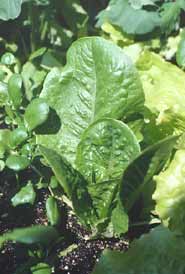
Salad days
Lettuce is probably the easiest greenhouse crop to grow. 'Ostinata', 'Winter Density', and 'Baby Oak Leaf' transplanted in April were harvested in about 30 to 45 days. I also grew 'Black-Seeded Simpson' successfully in summer, transplanting it in August, but couldn't get it to produce well in winter without supplemental lighting. 'Early Bird' eggplant and 'Ace' pepper transplanted in April grew well, but production was limited by a severe aphid infestation.The aphids also lessened the yields on an experimental crop of mid-winter mustard greens. I direct seeded 'Osaka Purple' mustard greens in late January without supplemental light. The plants grew slowly in low light conditions and battled the aphids, but by early April I harvested a small crop of fresh, tasty greens.
The bed wasn't monopolized by vegetables. 'Super Elfin' impatiens were the best flowering plants in the greenhouse. Plants transplanted into the bed in October provided color and cover for ladybug larvae throughout the winter and well into the spring. Jewel nasturtiums planted in August grew well for two months until their foliage browned and the flowering was reduced by the shorter days.
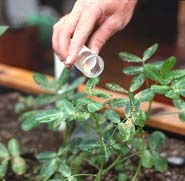
A Haven for Bugs
With heavy traffic through the greenhouse and outdoor flower beds close to the windows, I knew pests would be a major problem. Since many people work in or near the greenhouse, I use only organic insect sprays and insect predators to control pests.
The first culprits were aphids on the eggplant. Insecticidal soap knocked them down, but lured by the potential of an endless dinner, the aphids quickly returned. Pyrethrum was even more effective than the soaps, but again the aphids made a comeback. The most effective method was diligent hand crushing and occasional spraying for the winged adults.
In winter I experimented with releasing ladybugs. They caused quite a stir. The adults were found crawling in the conference room, on windowsills, in offices upstairs--everywhere but on the plants. They seemed more interested in escaping and hibernating than eating aphids, so I was surprised three months later to find ladybug larvae consuming aphids on the mustard greens and impatiens. Once the weather turned warm and the larvae turned to adults, out they went whenever the front door opened.
The second major pest was whiteflies -- especially on tomatoes. The population grew quickly in spite of three yellow sticky traps hung around the plants and weekly soap and pyrethrum sprays. I removed the tomato crops prematurely. The final insect problem was spider mites. I first noticed their webs on the citrus, mint, and banana leaves. At that point they were well on their way to causing substantial damage. However, misting daily and releasing Phytosieuluspe persimilis, a predatory mite, were effective controls. The predatory mite population reproduces faster than the two-spotted spider mite population because of the high humidity in the greenhouse. Two weeks after the release of the predatory mites, there were no signs of the spider mites.
Tomorrow is Another Day
As I write, we have cucumbers vining, cotton blooming, and a new crop of tomatoes growing in the greenhouse. I hope to experiment with more tomato trellis systems, 6-week tomato plantings for continuous crops and a few other beneficials, such as Encarsia formosa for whiteflies and green lacewings for aphids, to establish a long-term predator population and keep the pest numbers low.
Translating fantasy into reality isn't always easy, but the rewards of fresh tomatoes and ripe papayas in February and fragrant jasmine in March keep me inspired.
Charlie Nardozzi is the senior horticulturist at National Gardening.
Photography by National Gardening Association
 Charlie Nardozzi is an award winning, nationally recognized garden writer, speaker, radio, and television personality. He has worked for more than 30 years bringing expert gardening information to home gardeners through radio, television, talks, tours, on-line, and the printed page. Charlie delights in making gardening information simple, easy, fun and accessible to everyone. He's the author of 6 books, has three radio shows in New England and a TV show. He leads Garden Tours around the world and consults with organizations and companies about gardening programs. See more about him at Gardening With Charlie.
Charlie Nardozzi is an award winning, nationally recognized garden writer, speaker, radio, and television personality. He has worked for more than 30 years bringing expert gardening information to home gardeners through radio, television, talks, tours, on-line, and the printed page. Charlie delights in making gardening information simple, easy, fun and accessible to everyone. He's the author of 6 books, has three radio shows in New England and a TV show. He leads Garden Tours around the world and consults with organizations and companies about gardening programs. See more about him at Gardening With Charlie.